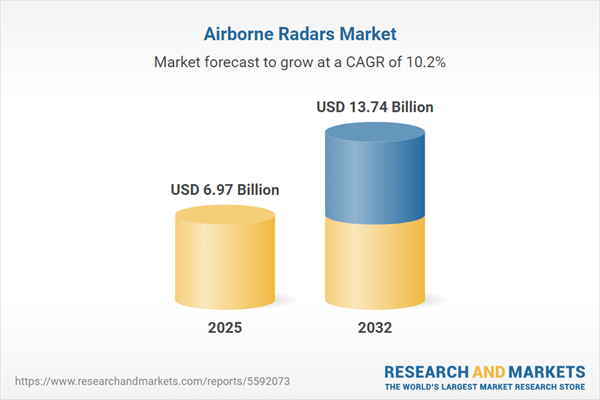Speak directly to the analyst to clarify any post sales queries you may have.
The global airborne radars market is rapidly advancing as organizations seek solutions that deliver operational flexibility, reliable performance, and procurement scalability in a changing regulatory and mission landscape. Senior leaders are prioritizing adaptive radar platforms to ensure readiness and operational excellence across increasingly dynamic aviation scenarios.
Market Snapshot: Airborne Radars Market Growth and Dynamics
The airborne radars market is shaped by a strong demand for improved situational awareness and the ongoing modernization of aviation infrastructures in both military and civil sectors. Stakeholders are implementing radar technologies that facilitate integrated scanning, seamless data exchange, and coordinated workflows across varied aviation assets. Modern airborne radars now underpin both manned and unmanned operations, delivering agility for evolving missions and operational complexity. Technology innovation remains crucial, as it reduces deployment times, enhances interoperability among fleets, and supports mission success. These dynamics continue to drive public and private investment in comprehensive radar solutions that align with strategic objectives and regulatory expectations.
Scope & Segmentation of the Airborne Radars Market
Understanding segmentation is vital for stakeholders aiming to optimize airborne radar acquisitions and streamline compliance and performance objectives. Targeted investments across key segments fuel effective technology adoption and ensure tailored solutions for complex aviation needs.
- End User: Civil aviation authorities and military organizations leverage airborne radars to boost airspace oversight, meet regulatory requirements, conduct surveillance tasks, and support current or planned fleet expansions.
- Operation: Offerings include pod-mounted and integrated radar systems, enabling deployment adaptability and mission-specific configurations for a range of aircraft types and operational profiles.
- Technology: Systems employ active electronically scanned arrays (AESA), mechanical scan, and passive electronically scanned arrays (PESA), ensuring compatibility with modern and legacy aircraft to support phased fleet upgrades and mission adaptation.
- Frequency: Radar platforms utilize Ka, Ku, L, S, and X-bands, permitting operators to select the most appropriate band for unique environmental conditions, application requirements, and regulatory standards.
- Platform: Airborne radar platforms equip fighter jets, helicopters, transport aircraft, and unmanned aerial vehicles, responding to a broad spectrum of operational scenarios from high-speed maneuvers to extended surveillance missions.
- Function: Solutions deliver early warning, terrain mapping, ground and maritime surveillance, and weather detection functionalities, enabling organizations to maintain comprehensive situational awareness in diverse missions.
- Regions: The Americas, Europe, Middle East and Africa, and Asia-Pacific regions each display distinct patterns of adoption shaped by regional market drivers, security considerations, and compliance requirements.
- Leading Companies: Providers such as Raytheon Technologies Corporation, Northrop Grumman Corporation, Lockheed Martin Corporation, Thales S.A., Leonardo S.p.A., Saab AB, L3Harris Technologies, Inc., Hensoldt AG, BAE Systems plc, and Mitsubishi Electric Corporation deliver advanced radar solutions for global aviation organizations.
Key Strategic Takeaways for Stakeholders
- Adopting software-defined radar architectures drives operational agility and allows for secure, remote updates with minimal mission impact.
- Emerging integration of artificial intelligence and digital beamforming significantly enhances target detection and accuracy in high-density or contested airspace environments.
- Modular system designs give organizations flexibility to implement incremental upgrades, aligning with evolving regulatory demands and mission requirements without large-scale system overhauls.
- Diverse radar product portfolios—spanning portable, pod-mounted, and fixed installations—enable scalable solutions for temporary needs and ongoing aviation operations.
- Collaborative partnerships with technology providers and strategic supply chain planning reinforce procurement resilience and ensure continuity amid volatility in sourcing environments.
Tariff Impact Highlight: Navigating Cost and Supply Chain Pressures
Recent U.S. tariff policies have led market leaders to reconsider sourcing models, emphasizing local procurement and domestic assembly to increase resilience. Sourcing and procurement teams are prioritizing supply chain transparency, adapting to shifting regulations, and enhancing program continuity in the face of globalization and fluctuating trade dynamics.
Research Methodology & Data Sources
This market insight integrates quantitative forecasts and qualitative assessments, utilizing supplier announcements, industry research, and the latest technical advancements. The balanced research approach provides a current and reliable view, informing strategy for organizational leaders.
Why This Report Matters for Industry Stakeholders
- Delivers actionable analysis of airborne radar development, deployment patterns, and adoption trends, supporting leadership in targeted investment and long-term modernization strategies.
- Guides organizations through regulatory transitions and cross-platform integration, while reinforcing resilience in supply chains and resource planning.
- Supplies senior executives with insights critical to aligning technology adoption with mission goals and overall organizational performance.
Conclusion
Ongoing technical innovation and flexible sourcing strategies are shaping the future direction of the airborne radars market. This report offers senior decision-makers the clarity needed to drive effective solutions for evolving mission and business objectives.
Additional Product Information:
- Purchase of this report includes 1 year online access with quarterly updates.
- This report can be updated on request. Please contact our Customer Experience team using the Ask a Question widget on our website.
Table of Contents
3. Executive Summary
4. Market Overview
7. Cumulative Impact of Artificial Intelligence 2025
Companies Mentioned
The companies profiled in this Airborne Radars market report include:- Raytheon Technologies Corporation
- Northrop Grumman Corporation
- Lockheed Martin Corporation
- Thales S.A.
- Leonardo S.p.A.
- Saab AB
- L3Harris Technologies, Inc.
- Hensoldt AG
- BAE Systems plc
- Mitsubishi Electric Corporation
Table Information
| Report Attribute | Details |
|---|---|
| No. of Pages | 184 |
| Published | October 2025 |
| Forecast Period | 2025 - 2032 |
| Estimated Market Value ( USD | $ 6.97 Billion |
| Forecasted Market Value ( USD | $ 13.74 Billion |
| Compound Annual Growth Rate | 10.1% |
| Regions Covered | Global |
| No. of Companies Mentioned | 11 |









